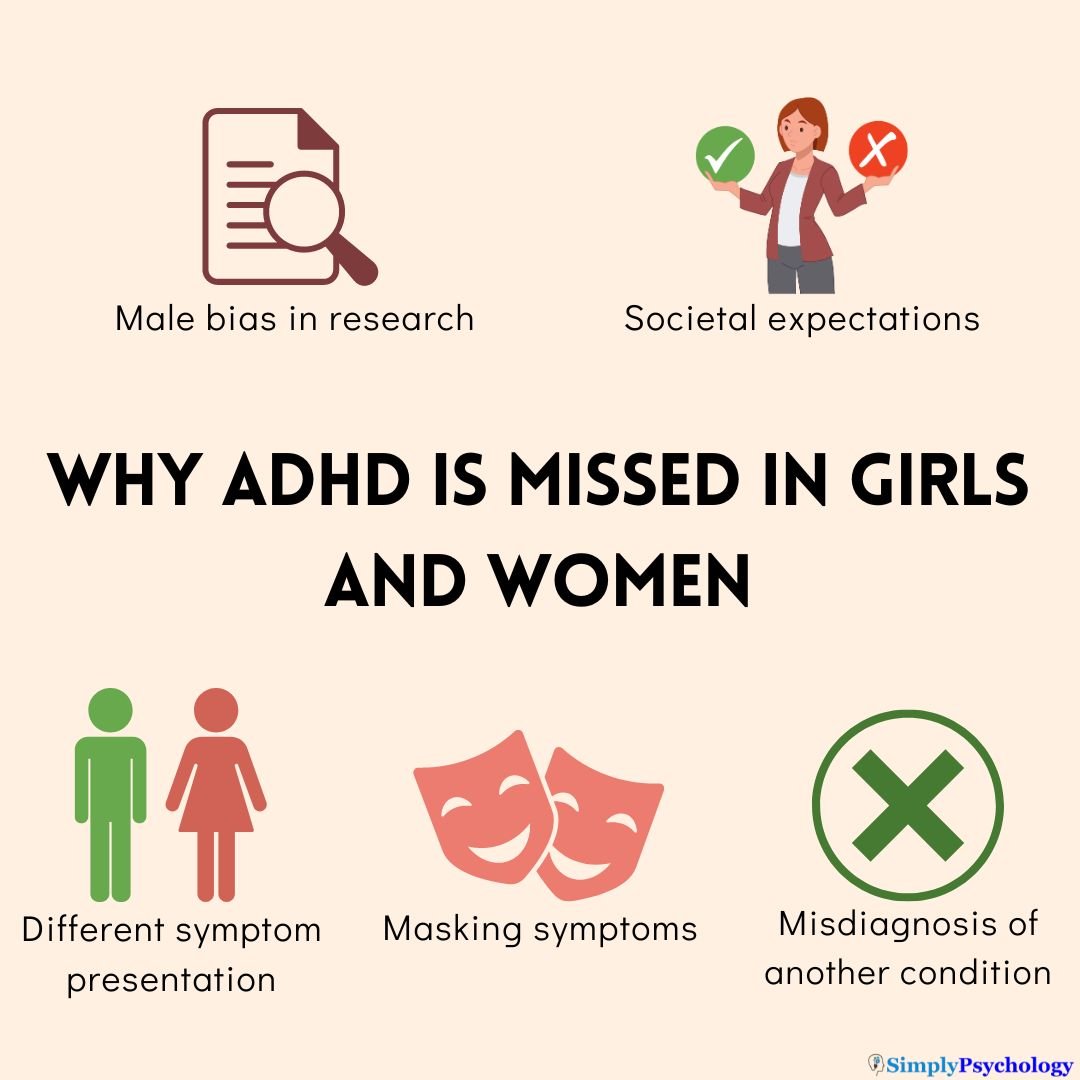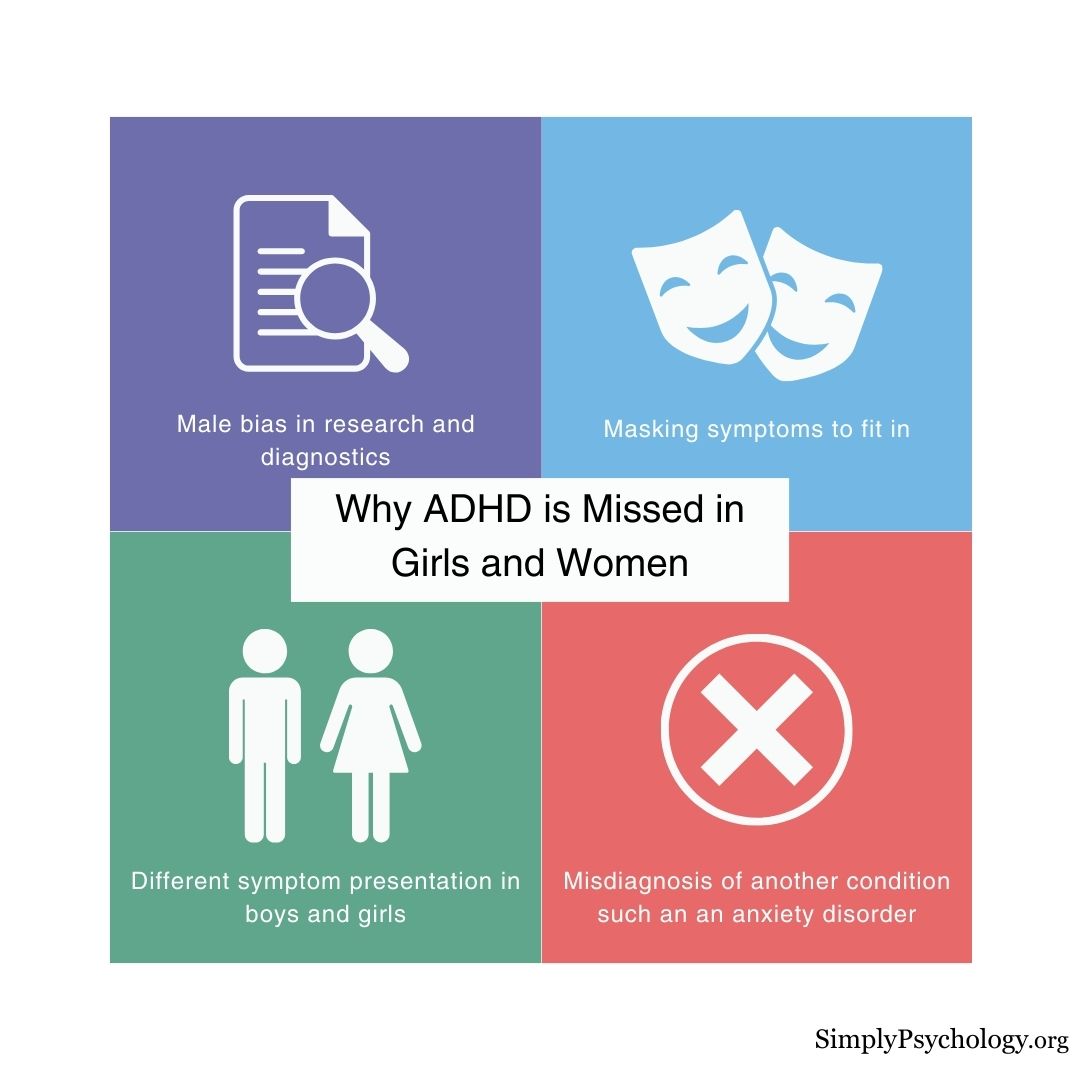Attention-deficit/hyperactivity disorder (ADHD) is often overlooked and undiagnosed in girls and women.
This article explores some of the key reasons why females with ADHD tend to be underdiagnosed.
These include the fact that ADHD is viewed as a “male” condition, differences in how ADHD manifests in girls versus boys, societal expectations of girls’ behavior, tendencies for girls to internalize and mask symptoms, and misdiagnoses of comorbid mood disorders.

ADHD is a condition that is more commonly diagnosed in males than females, typically three times as many males are diagnosed (Barkley, 2006).
When recognized, ADHD tends to be diagnosed later in girls (at an average age of 17, compared to an average age of 8 in boys). Adult studies report that similar numbers of men and women are now being diagnosed with ADHD, suggesting that this disorder is just as likely to occur in girls, but there is a significant delay (WHO, 2019).
Without an accurate ADHD diagnosis, girls and women miss out on opportunities for proper treatment and support. Highlighting the unique presentation of ADHD in females and spreading awareness is crucial to improving identification rates and outcomes.
Below are some of the reasons why girls and women may miss a diagnosis of ADHD:
ADHD is seen as a ‘male disorder’
There are likely many girls and women who are not diagnosed because their signs of ADHD are being missed or are not as explicit as those displayed by boys and men.
The hyperactive, impulsive, and disruptive behaviors often displayed by boys with ADHD reinforce the stereotype that it is a disorder that affects young boys.
Harry has trouble sitting still in class, often fidgeting with his hands and rocking back and forth on his chair. He often calls out answers in class without raising his hand and commonly has play fights with his friends in the playground. Harry's teacher puts in a referral for him to be assessed for ADHD. Chloe finds it hard to concentrate in class. She often daydreams, forgets to complete homework, and underperforms as a result. With her classmates, she has trouble taking turns and struggles to make close friends. Since Chloe is not as disruptive or as rowdy as Harry, she does not get referred for an ADHD assessment.
The discrepancy that males are diagnosed more than girls on a ratio of 3:1 highlights that many girls with ADHD are likely to remain unidentified and untreated rather than the idea that there are simply fewer girls with ADHD.

Research on ADHD
The diagnostic criteria and general understanding of ADHD today are mainly based on observations of how the disorder manifests in young boys.
It wasn’t until 1979 that girls and women were included in systematic research on ADHD. Before that, all research focused on boys and men.
“ADHD is stereotypically viewed as a disorder for boys and one that is indicated by hyperactivity/impulsivity, leading to a lack of diagnosis and representation in research of females with the disorder… In the past 40 years or so, most samples for studying ADHD have had few female participants.”
Rosenthal (2021).
This lack of research on girls and women means that rating scales are also based predominantly on male samples, which may disadvantage their generalizability to females.
Without sufficient research into girls and women with ADHD, our ideas on how ADHD should present itself will be based on how it manifests in males.
“We’re doing a better job than in the past, but we don’t know as much as we would like to about how ADHD impacts girls and women, especially into adulthood… research that explores long-term outcomes of ADHD in girls and women – especially work that investigates how and why the disorder contributes to difficulties across the life span – will improve treatment and help females who have ADHD.”
Rosenthal (2021).
Different presentation
From the research that exists on girls with ADHD, it is now understood that girls are more likely to present with inattentive rather than hyperactive signs, which are more common among boys (Hinshaw, 2021).
Common signs of inattention in females include forgetfulness, being easily distracted, daydreaming, low motivation, and disorganization.
These symptoms may be less overt manifestations of ADHD despite still being impairing.
“While those symptoms may cause problems in their lives, they can be overlooked by clinicians. Also, girls and women may develop strategies to compensate for these challenges, making their struggles even more difficult for others to notice.”
Rosenthanl (2021).
Girls and women are still believed to have impulsive signs of ADHD. However, these may manifest as a tendency to disrupt others, say whatever comes to mind, act on impulses, and suddenly change direction in life.
While these signs may also be present in boys, if these are present in girls without obvious outward hyperactive signs, many may misinterpret these as signs of emotional difficulties or disciplinary problems rather than signs of ADHD.
Research has found that girls with ADHD predominately have the inattention type of the disorder, alongside associated internalizing problems, while boys with ADHD predominately have the hyperactive-impulsive type with associated externalizing problems (Hinshaw et al., 2021).
It is also thought that many ADHD signs and externalizing problems only become more salient in girls as they reach puberty, in contrast to boys, whose signs and externalizing problems are more noticeable in earlier childhood.
The externalizing problems, hyperactive and interruptive behaviors often seen in boys are most likely to lead to a referral. The combination of mostly inattentive signs, alongside fewer externalizing problems, means that these signs of these girls can be easily missed by teachers and parents or misunderstood as something else.
Societal expectations and beliefs
As there is often an understanding that ADHD is a condition associated with boys who are ‘disruptive,’ if a girl displays similar signs, people may not be as inclined to consider she may have ADHD.
Likewise, hyperactive signs are commonly judged to be less socially acceptable in girls than in boys, and the hyperactive signs in girls may be misinterpreted as emotional problems.
For example, girls with ADHD may be labeled as simply ‘moody’ or ‘too emotional.’
Teachers and parents may underestimate impairment in girls and overlook their symptoms compared to boys due to gender biases and expectations (Mowlem et al., 2018).
For example, if a girl is viewed as shy, inattentive, and unfocused in class, a teacher may assume this is typical behavior of a girl who daydreams a lot.
Girls with ADHD tend to exhibit relational aggression rather than physical aggression, meaning their behavioral issues may be perceived as less problematic (Young et al., 2020).
Dana often gets into arguments with her friends at school. When she feels upset or frustrated with peers, Dana will give them the silent treatment, exclude them from activities, or spread rumors about them behind their backs. While these behaviors hurt Jenny's friends emotionally, teachers and parents view her actions as typical "mean girl" relational aggression. They assume it's just normal drama among middle school girls.
Dana’s relational aggression is not recognized as a symptom of underlying ADHD and poor emotional regulation. Instead, it is dismissed as normal girl behavior.
This demonstrates how the type of aggression exhibited more commonly by girls with ADHD may lead to their symptoms being minimized.
Misdiagnosis and coexisting conditions
Internalizing problems such as depression and anxiety are often more prominent in girls with ADHD. Sometimes, these internalized problems can be more noticeable than the other ADHD signs, meaning that they can overshadow the presence of ADHD and delay a diagnosis (Hinshaw et al., 2021).
Moreover, not receiving an earlier diagnosis and missing out on appropriate support may make the internalized problems worse or lead to the development of a co-existing mental health condition, which can mean that ADHD is even less noticeable.
A lot of the time, girls and women do not seek help for their ADHD until they have developed comorbid conditions.
Often, girls and women who have undiagnosed ADHD get diagnosed as having another disorder, such as a mood disorder.
A study found that around 46% of women were misdiagnosed with another disorder before being diagnosed with ADHD (Center For ADHD Awareness Canada, 2021):
“I wasted over a decade being prescribed antidepressants and anti-anxiety medications that did nothing or made things worse. I haven’t been nearly as depressed since starting ADHD medication and I have only had occasional episodes of depression since then. Anxiety is also better with ADHD medication but it took me longer to get it fully under control because I had so many years of trauma from untreated ADHD.”
It may not be until adulthood that women realize for themselves that they have ADHD.
‘It’s quite common that women actually present into mental health services with anxiety or low mood. But actually underlying those difficulties is often an undiagnosed ADHD.’
Dr Jo Steer, Clinical Psychologist
Masking
It is thought that girls with ADHD will often mask their signs to fit in with their peers.
Masking refers to strategies neurodiverse individuals use to appear more neurotypical, especially in social situations.
A girl with ADHD may learn from societal expectations that she should be quiet and obedient, so she learns to hold back on her ADHD signs, perhaps becoming withdrawn in social situations so that she makes friends.
Women with ADHD may mask their struggles of sticking to deadlines and organizing their life by presenting as more capable and putting in extra work to appear as if their struggles aren’t there.
If girls are effectively masking their signs, it can be harder for others to notice that they have any difficulties, making it less likely that they will be referred for a diagnosis.
A reason for this may be that girls are often expected to be more socially polite and ‘well-behaved’ compared to boys, and so they learn to present in ways that are deemed more acceptable, which can make it harder for girls to get a diagnosis.
Examples of masking behaviors that girls and women may use:
- Blaming forgetfulness on a lack of sleep
- Excessively taking notes in class or doing all-nighters to prepare for a test
- Claiming to work better under pressure
- Making a conscious effort to stop yourself from fidgeting
- Holding back on speaking or sharing opinions in conversations
- Pretending to be calm and put-together in social situations but then being upset and frustrated when alone
Consequences of a late diagnosis
A late ADHD diagnosis in girls and women can have severe consequences across their lifespan.
Undiagnosed ADHD increases the risk for a variety of mental health issues, including higher rates of depression, anxiety, and self-harm (Hinshaw et al., 2012).
Girls with undiagnosed ADHD are more likely to internalize their struggles, perceiving their difficulties as personality traits, leading to low self-esteem and self-blame (Ringer, 2019).
Other consequences include increased risk for unplanned pregnancy, postpartum depression, and social isolation (Hinshaw et al., 2021).
As ADHD expert Dr. Amanda Kirby explains, a late diagnosis means that “many of us are emerging now at different stages of our lives, and some are looking back and thinking how much easier could it have been if I had known…”
Catching ADHD earlier in girls would allow for proper treatment and support to improve outcomes across social, emotional, behavioral, and academic domains.
Importance of a Diagnosis
Women and girls with ADHD may receive an accurate diagnosis that addresses the signs and other important issues with functioning and impairment.
This can help determine appropriate treatment and strategies for managing ADHD. Receiving a diagnosis of ADHD may help girls and women avoid:
- Feeling ashamed and blaming themselves for something they have little control over.
- Feeling like they have failed in life.
- Seeking stimulation that can negatively affect them.
- Coping strategies that are unhelpful and do more harm than good.
A diagnosis of ADHD can help women and girls have clarity on their behaviors, both past and present, and can reduce feelings of guilt about their behavior.
Before the diagnosis, girls may have been attributed labels such as ‘chatterbox,’ ‘drama queen,’ or ‘tomboy’ due to their signs.
Having a diagnosis of ADHD can help free them from these labels, and other people may be more compassionate and accommodating as a result.
Below are some personal accounts of women who have received an ADHD diagnosis and how their diagnosis can leave mixed emotions:
‘I think just ultimately, I feel a lot more comfortable in my own skin.’
Jasmine
‘I think I had multiple reactions; in some ways, it felt like a relief, because at least it means that I’m not lazy or stupid. On the other hand, I felt like it was an excuse.’
Christine
It was kind of a relief to get diagnosed; it kind of confirmed what I already knew in the back of my head, but I also felt hopeless. Because now I know it’s not me, it’s not like if I work harder I can do better. Sometimes, I feel very depressed, because no matter what I do, this is like a bad disease that I can never cure.
Amber
Many people with ADHD can lead successful and happy lives, but an accurate diagnosis is the first step to effectively managing the disorder.
When accurately diagnosed, ADHD can be better managed, leading to increased satisfaction in life and significant improvements in daily functioning.
References
Barkley, R. A. (2006). Attention-deficit hyperactivity disorder: A handbook for diagnosis and treatment.
Centre for ADHD Awareness, Canada. (2021). Girls and Women with ADHD: Our Missed, Forgotten and Most Vulnerable. https://www.caddac.ca/adhd/document/girls-and-women-with-adhd-our-missed-forgotten-and-most-vulnerable/
Hinshaw, S. P., Owens, E. B., Zalecki, C., Huggins, S. P., Montenegro-Nevado, A. J., Schrodek, E., & Swanson, E. N. (2012). Prospective follow-up of girls with attention-deficit/hyperactivity disorder into early adulthood: continuing impairment includes elevated risk for suicide attempts and self-injury. Journal of consulting and clinical psychology, 80(6), 1041.
Hinshaw, S. P., Nguyen, P. T., O’Grady, S. M., & Rosenthal, E. A. (2022). Annual Research Review: Attention‐deficit/hyperactivity disorder in girls and women: underrepresentation, longitudinal processes, and key directions. Journal of Child Psychology and Psychiatry, 63(4), 484-496.
Mowlem, F. D., Rosenqvist, M. A., Martin, J., Lichtenstein, P., Asherson, P., & Larsson, H. (2019). Sex differences in predicting ADHD clinical diagnosis and pharmacological treatment. European child & adolescent psychiatry, 28, 481-489.
Ringer, N. (2019). Young people’s perceptions of and coping with their ADHD symptoms: A qualitative study. Cogent Psychology, 6(1), 1608032
Rosenthal, E. (2021).Looking Back on 42 Years of Research on ADHD in Females. Duke Center for Girls & Women with ADHD. https://adhdgirlsandwomen.org/wp-content/uploads/2022/05/Hinshaw_2021_Review.pdf
World Health Organization. International Statistical Classification of Diseases and Related Health Problems 10th Revision (ICD-10): Version 2019. 2019.
https://icd.who.int/browse10/2019/en.
Young, S., Adamo, N., Ásgeirsdóttir, B. B., Branney, P., Beckett, M., Colley, W., … & Woodhouse, E. (2020). Females with ADHD: An expert consensus statement taking a lifespan approach providing guidance for the identification and treatment of attention-deficit/hyperactivity disorder in girls and women. BMC psychiatry, 20(1), 1-27.


